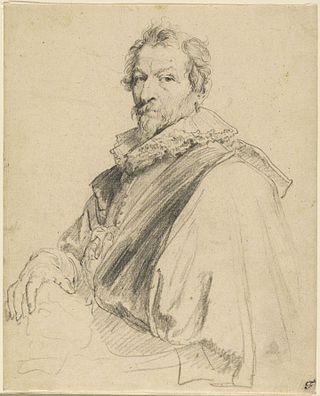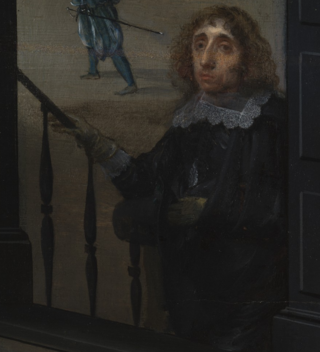
Sir Anthony van Dyck was a Flemish Baroque artist who became the leading court painter in England after success in the Spanish Netherlands and Italy.

Justus Sustermans, Joost Sustermans or Suttermans, his given name Italianised to Giusto, was a Flemish painter and draughtsman who is mainly known for his portraits. He also painted history and genre paintings, still lifes and animals.

Gonzales Coques was a Flemish painter of portraits and history paintings. Because of his artistic proximity to and emulation with Anthony van Dyck he received the nickname de kleine van Dyck. Coques was also active as an art dealer.

Cornelius Johnson or Cornelis Janssens van Ceulen was an English painter of portraits of Dutch or Flemish parentage. He was active in England, from at least 1618 to 1643, when he moved to Middelburg in the Netherlands to escape the English Civil War. Between 1646 and 1652 he lived in Amsterdam, before settling in Utrecht, where he died.

Cornelis de Vos was a Flemish painter, draughtsman and art dealer. He was one of the leading portrait painters in Antwerp and is best known for his sensitive portraits, in particular of children and families. He was also successful in other genres including history, religious and genre painting. He was a regular collaborator with Rubens.

Hendrick van Balen or Hendrick van Balen I was a Flemish Baroque painter and stained glass designer. Hendrick van Balen specialised in small cabinet pictures often painted on a copper support. His favourite themes were mythological and allegorical scenes and, to a lesser extent, religious subjects. The artist played an important role in the renewal of Flemish painting in the early 17th century and was one of the teachers of Anthony van Dyck.
This is a list of events that occurred in the year 1638 in art.

Cornelis de Wael was a Flemish painter, engraver and merchant who was primarily active in Genoa in Italy. He is known for his genre paintings, battle scenes, history paintings and still lifes. Through his art work, support for Flemish painters working in Italy and role as an art dealer, he played an important role in the artistic exchange between Italy and Flanders in the first half of the 17th century. His work also had an influence on local painters such as Alessandro Magnasco, particularly through his scenes of despair and irony.

Jan van den Hoecke was a Flemish painter, draughtsman and designer of wall tapestries. He was one of the principal assistants in Rubens' studio in the 1630s. He later traveled to Italy where he resided for a decade in Rome. He subsequently worked as a court painter in Vienna and Brussels. Jan van den Hoecke was a versatile artist who created portraits as well as history and allegorical paintings.

Adriaen Hanneman was a Dutch Golden Age painter best known for his portraits of the exiled British royal court. His style was strongly influenced by his contemporary, Anthony van Dyck.

Simon de Vos was a Flemish painter, draughtsman and art collector. He started his career making small-format cabinet pictures of genre scenes, in particular of Caravaggesque merry companies. Later he switched to history painting, working on larger formats in a Flemish Baroque style which was influenced by Rubens and van Dyck.

Flemish Baroque painting was a style of painting in the Southern Netherlands during Spanish control in the 16th and 17th centuries. The period roughly begins when the Dutch Republic was split from the Habsburg Spain regions to the south with the Spanish recapturing of Antwerp in 1585 and goes until about 1700, when Spanish Habsburg authority ended with the death of King Charles II. Antwerp, home to the prominent artists Peter Paul Rubens, Anthony van Dyck, and Jacob Jordaens, was the artistic nexus, while other notable cities include Brussels and Ghent.

Willem van Haecht was a Flemish painter best known for his pictures of art galleries and collections.

Lucas Franchoys the Younger or Lucas Franchoys II was a Flemish Baroque painter from Mechelen, who painted numerous altarpieces and portraits in a style reminiscent of Anthony van Dyck.

Marten Pepijn was a Flemish painter who was mainly known for his large-scale history paintings and to a lesser extent for his smaller genre scenes.

George Geldorp, Georg Geldorp or Jorge Geldorp was a Flemish painter who was mainly active in England where he was known for his portraits and history paintings. He was also active as an art dealer and impresario.

Cornelis van der Geest was a spice merchant from Antwerp, who used his wealth to support the Antwerp artists and to establish his art collection. He was also the dean of the haberdashers guild.

Samson and Delilah is a 1630 painting by Anthony van Dyck. Like his 1620 version of the subject, it is in the style of his former master Peter Paul Rubens. Unlike Rubens, however, van Dyck shows Delilah seemingly appalled at her own betrayal of Samson and regretting her act of treason, whereas Rubens showed him as a captive and her as an unscrupulous temptress. Van Dyck's palette in the work also reveals the influence of Titian during van Dyck's stay in Italy. It is now in the Kunsthistorisches Museum in Vienna.

The Self-portrait is an oil on canvas painting by the Flemish artist Anthony van Dyck. It is held at the Metropolitan Museum of Art, in New York. The work depicts its creator during his early twenties.

Margaret Lemon was an English artist's model. She was the most painted female commoner of the seventeenth century, and she was the partner of Anthony van Dyck.



















